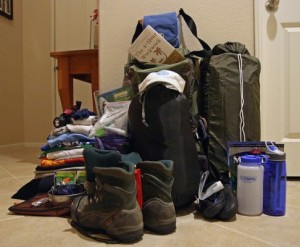Scout Gear
This resource is designed to help you choose your camping equipment wisely. Members of Troop 701 are encouraged to check our gear exchange, especially for boots and clothing.
What every Scout should have as soon as possible:
1. Hiking Boots. These should fit well with hiking socks, stay dry and be comfortable when worn for days at a time.
2. Sleeping Bag and Ground Pad. Bag: Look for a bag with a 15-20 degree rating. Synthetic fill is recommended for scouts as it is lightweight and low maintenance. An adult size bag is recommended as the scout will outgrow a youth bag. You will find options with shape and design. Mummy bags will stay warmer and pack smaller. A built in hood will also increase warmth. This will probably be your most expensive item, but it is an important investment for a successful scouting experience. Ground Pad: The rating on a sleeping bag is based on the assumption that a ground pad is in use. Lots of options for this, make sure it is not difficult to pack and carry.
3. Rain Gear. A waterproof outer layer. Buy one size up so that it can be worn over layers and give some room to grow into.
4. Tarp. Small, blue plastic type is fine, 8×10. Each scout will need a tarp whenever we tent camp.
5. Duffel Bag. Sturdy, soft sided. No wheels. Wheeled bags damage the tents, and after one outing at camp the wheels will be ruined anyway.
6. Wool or Synthetic Socks. A Scout will need 2-3 pair at least. You can spend a lot of money or not on these. Hiking socks that are not cotton can be purchased at Costco, Target, Walmart, TJ Maxx, etc. Sporting goods store or outfitters have higher end ones if you want to go there. Read the label. Cotton gets wet and stays wet, and will lose its ability to hold heat when wet.
7. Headlamp. Battery operated.
8. Water Bottle. 1 liter, make sure it does not leak.
Looking ahead to October and November camps:
1. Base Layer. Synthetic (not cotton) Under Armour – type garments. Like socks, you do not need to go with high end products. Bottoms: full length; Top: long sleeve.
2. Good cool-weather jacket. A fleece or other synthetic layer. A down jacket is also great, but can be expensive. Look for a layer that is made well, and can be worn between 40 and 60 degrees, in the evening, etc. It can also be used as a layer during the winter, under their rain jacket.
3. Gloves and Hats for warmth. Extra gloves take up very little space but can make a difference between being miserable or not.
Looking even further ahead; not needed right away but might be something to think about:
Sleeping Bag Liner. This item can add comfort and warmth to any bag. Another advantage: they are easy to launder and help keep the sleeping bag clean, which will help it last longer.
Internal-frame backpack. Younger scouts are welcome to borrow a pack from the troop, as we have quite a few, and if you purchase a pack right away, chances are that the scout will outgrow it. If you are in the market for a pack, your scout should be properly sized at a location that specializes in hiking gear, and they should take their gear (clothes, sleeping bag, ground pad, etc.) with them when they are shopping. A fitting should include trying several packs. Compare this purchase to buying shoes that you’ll be wearing for extended periods—the fit should be really good.
Some additional notes:
- Remember the gear exchange…. Feel free to get gear or donate items in good condition that your son no longer needs.
- Your scout will not need to purchase a tent, cooking equipment or a mess kit.
- Label EVERYTHING.
- Be familiar with and follow the manufacturer’s care instructions for your items.
- Don’t be shy about asking an older scout or an adult leader for advice if you have questions about gear. Troop guides are an excellent resource for this. If you purchase an item and want someone to look at it for you, leave the tags on it , save the receipt, and bring it to a troop meeting.

